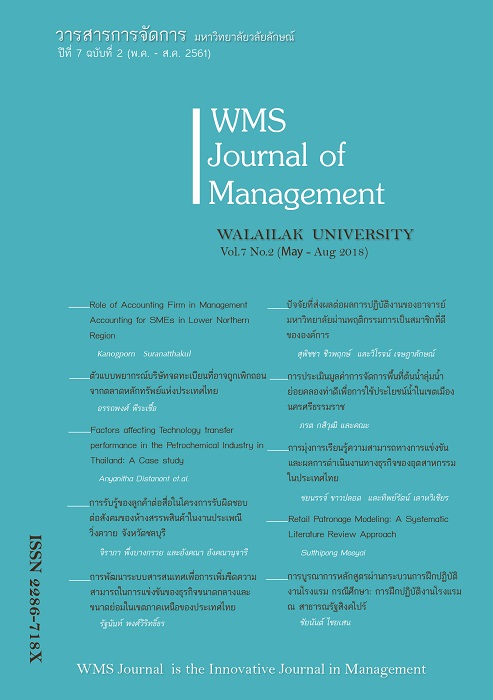Valuation of Khlong Thadee Watershed Management for Water Utilization in Urban Area of Nakhon Si Thammarat
Main Article Content
Abstract
The increase in population, change in agricultural pattern and water consumption in urban area of Nakhon Si Thammarat have resulted in the negative impacts to Khlong Thadee Watershed’s resources. The objectives of this study were to analyze watershed management attributes and to evaluate the willingness to pay of household for improvement of better water resources. The data were collected by proportional stratified random sampling from 304 household water user samples in the city of Nakhon Si Thammarat. The analysis was done using choice modeling method. The results showed that the significant attributes that influenced the willingness to pay of household were changing pattern of farming, educating and raising awareness. Households were willing to pay more for improvement of those watershed management attributes. Especially, integrated farming system and organic farming were the most important attributes that household was willing to pay more for the improvement of better water resources at 141.73 Baht per month. Hence, government should consider a policy on payment for ecosystems service appropriately.
Article Details
References
เก นันทะเสน. (2551). ความเต็มใจยอมรับมาตรการการอนุรักษ์ดินและน้ำของเกษตรกรในพื้นที่ลุ่มน้ำแม่สาตอนบน จังหวัดเชียงใหม่. วิทยานิพนธ์วิทยาศาสตรมหาบัณฑิต, มหาวิทยาลัยเชียงใหม่.
เกษม จันทร์แก้ว. (2551). หลักการจัดการลุ่มน้ำ. กรุงเทพ. สำนักพิมพ์มหาวิทยาลัยเกษตรศาสตร์.
คณพัฒน์ ทองคำ และคณะ. (2556). โครงการวิจัยเพื่อการพัฒนาระบบบูรณาการความ ร่วมมือในระดับพื้นที่ กรณีประเด็นเพื่อการจัดการทรัพยากรน้ำ และภัยพิบัติจากน้ำอย่างมีส่วนร่วมลุ่มน้ำย่อยคลองท่าดี จังหวัดนครศรีธรรมราช. สืบค้นเมื่อ 22 เมษายน 2558, สืบค้นจาก http://elibrary.trf.or.th/project_content.asp?PJID=RDG55A0011.
เจิดนภางค์ ไชยเลิศ. (2548). การประเมินมูลค่าการใช้ประโยชน์จากพื้นที่ลุ่มน้ำ: กรณีศึกษาลุ่มน้ำห้วยทึม อำเภอทองผาภูมิ จังหวัดกาญจนบุรี. วิทยานิพนธ์วิทยาศาสตรมหาบัณฑิต, มหาวิทยาลัยเกษตรศาสตร์.
ชลทิชา จันทร์แจ่ม. (2559). การประเมินมูลค่าคุณลักษณะกาแฟคั่วบดที่ผลิตเชิงอนุรักษ์ บนพื้นที่สูงโดยผู้บริโภคในเขตกรุงเทพมหานคร. วิทยานิพนธ์วิทยาศาสตรหาบัณฑิต สาขาการจัดการทรัพยากร, มหาวิทยาลัยเกษตรศาสตร์.
ที่ทำการปกครองจังหวัดนครศรีธรรมราช. (2557). สถิติจำนวนประชากรจังหวัดนครศรีธรรมราช. สืบค้นเมื่อ 22 เมษายน 2558, สืบค้นจาก www.pokkrongnakhon.com/datacenter/state.php.
เทศบาลเมืองทุ่งสง และองค์กรความร่วมมือระหว่างประเทศของเยอรมัน. (2555). การบริหารจัดการน้ำแบบบูรณาการในลุ่มน้ำสาขาแม่น้ำตรังระหว่างจังหวัดนครศรีธรรมราชและจังหวัดตรัง. สืบค้น เมื่อ 22 เมษายน 2558, สืบค้นจากwww.tungsong.com/river_trang/ 21072557/document/book.pdf.
นพดล สนวิทย์. (2556). ความเต็มใจจ่ายของครัวเรือนเพื่อการปรับปรุงคุณภาพน้ำประปาในเขตพื้นที่ลุ่มน้ำแม่สา. วิทยานิพนธ์วิทยาศาสตรมหาบัณฑิต, มหาวิทยาลัยแม่โจ้.
นิวัติ เรืองพานิช. (2547). หลักการจัดการลุ่มน้ำ. เล่ม 4. โครงการตำราชุดการจัดการและ อนุรักษ์ทรัพยากรธรรมชาติ. กรุงเทพฯ: ศูนย์ส่งเสริมวิชาการ.
บรรพต บุตกะ. (2550). การประเมินมูลค่าทางเศรษฐศาสตร์ในการจัดการช้างป่าในประเทศไทย. วิทยานิพนธ์วิทยาศาสตรมหาบัณฑิต สาขาการจัดการทรัพยากร, มหาวิทยาลัยเกษตรศาสตร์.
ปราโมทย์ เชี่ยวชาญ. (2551). ระบบปรับปรุงคุณภาพน้ำ. จุลสารสาขาวิชาวิทยาศาสตร์สุขภาพ. มกราคม 2551.
พนารัตน์ ชิโนเรศโยธิน. (2543). การประเมินมูลค่า การใช้ประโยชน์ทางตรงของบึงบอระเพ็ด จังหวัดนครสวรรค์. วิทยานิพนธ์วิทยาศาสตรมหาบัณฑิต, มหาวิทยาลัยเกษตรศาสตร์.
วชิราภรณ์ ด้วงโสน. (2552). การวิเคราะห์ปัจจัยที่เกี่ยวกับคุณภาพและความปลอดภัยที่มีผลต่อความพึงพอใจของผู้บริโภคลำไยในเขตกรุงเทพมหานคร. วิทยานิพนธ์วิทยาศาสตรมหาบัณฑิต, มหาวิทยาลัยเกษตรศาสตร์.
วราภรณ์ ปัญญาวดี และคณะ. (2555). “ความท้าทายและอุปสรรคในการประยุกต์ใช้มาตรการกำหนดค่าตอบแทนเพื่อบริการด้านสิ่งแวดล้อม: กรณีเกษตรเพื่อการอนุรักษ์ในเขตพื้นที่ลุ่มน้ำแม่สา จังหวัดเชียงใหม่.” วารสารการจัดการสิ่งแวดล้อม. 8 (2): 89-107.
สมพร อิศวิลานนท์. (2540). เศรษฐศาสตร์ ทรัพยากรธรรมชาติและสิ่งแวดล้อม: หลักและทฤษฎี. เลิศชัยการพิมพ์.
สันติ แสงเลิศไสว. (2549). การประเมินความพึงพอใจของผู้บริโภคที่มีต่อพืชผักปลอดภัย ตราดอยคำในเขตกรุงเทพมหานคร: วิธีแบบจำลองทางเลือก. วิทยานิพนธ์วิทยาศาสตรมหาบัณฑิต, มหาวิทยาลัยเกษตรศาสตร์.
สันติ แสงเลิศไสว. (2558). แนวคิดและทฤษฎีสำหรับการวิเคราะห์แบบจำลองสำหรับตัวแปรตามมีลักษณะไม่ต่อเนื่อง (Discrete Choice Model). เอกสารประกอบการอบรม. คณะเศรษฐศาสตร์, มหาวิทยาลัยเกษตรศาสตร์.
โสมสกาว เพชรานนท์. (2553). เศรษฐศาสตร์ สิ่งแวดล้อม. กรุงเทพมหานคร: มหาวิทยาลัยเกษตรศาสตร์.
สำนักชลประทานที่ 15. (2558). ข้อมูลทั่วไปและประวัติความเป็นมาจังหวัดนครศรีธรรมราช. สืบค้นเมื่อ 22 เมษายน 2558, สืบค้นจาก www.irrigation.rid.go.th/rid15/nsto/data_project/data_general.html.
สุวรรณา ชาวบ้านเกาะ. (2545). มูลค่าความปลอดภัยจากสารเคมีตกค้างในผัก: วิธีแบบจำลองทางเลือก. วิทยานิพนธ์วิทยาศาสตรมหาบัณฑิต,มหาวิทยาลัยธรรมศาสตร์.
องค์กรความร่วมมือระหว่างประเทศของเยอรมัน. (2557). การปรับตัวโดยอาศัยระบบนิเวศ ในภาคน้ำ. สืบค้นเมื่อ 22 เมษายน 2558, สืบค้นจาก www.ecoswat-thailand.com/download/eba- presentation-140707th.pdf.
อุดมศักดิ์ ศีลประชาวงศ์. (2557). “การศึกษาความเต็มใจจ่ายของนักท่องเที่ยวในการจัดการสภาพแวดล้อมของเกาะเสม็ด.” วารสารเศรษฐศาสตร์ปริทรรศน์.
สถาบันบัณฑิตพัฒนบริหารศาสตร์. 8 (1): 118-136.
Adamowicz, W., J. Louviere and J. Swait. (1998). Introduction to Attribute-Based Stated
Choice Methods. Resource Valuation Branch Damage Assessment Center NOAA – National Oceanic and Atmospheric Administration US Department of Commerce.
Bateman, I.J., et al. (2002). Economic Valuation with Stated Preference Techniques. UK: Edward Elgar.
Befikadu, A. L. (2015). “Determinants of WTP and WTA in watershed management: for linking land tenure, use and shared prosperity in a PES intervention in the Blue Nile Basin,Ethiopia.” Annual World Bank Conference on Land and Poverty. Washington DC.
Berggren, M. and S. Stahl. (2003). Paying for Environmental Services: A Choice Experiment of Water in Turrialba Costa Rica. Department of Environmental Economics School of Economics and Commercial Law, Gothenburg University.
Birol, E., K. Karosakis and P. Koundouri. (2006). “Using A Choice Experiment for Preference Heterogeneity in Wetland Attributes: The case of Cheimaditida Wetland in Greece.” Ecological Economic. 60 (7): 145-156.
Bliemer, M.C.J. and J.M. Rose. (2013). “Sample size requirements for stated choice experiments.” Transportation. 40: 1021–1041.
Hanemann, M. (1984). “Welfare evaluations in contingent valuation experiments with discrete responses.” American Journal of Agricultural Economics. 66 (3): 332-341.
Khamsay, P., et al. (2015). “Economic Valuation of River Conservation towards International Tourists’ Preferences and Willingness to Pay for Ecofriendly
Services of Hotel Industry: A Case Study of Namxong River in Vangvieng District, Laos.” Journal of Water Resource and Protection. 7: 897-908.
Lancaster, K. (1966). “A New Approach to Consumer Theory.” Journal of Political Economy. 74 (2): 132-157.
Mohd R. Y., Alias R., and Zaiton S. (2011). “Willingness to Pay for Domestic Water Service Improvements in Selangor, Malaysia A Choice Modeling Approach.”
International Business and Management. 2 (2): 30-39.
Sangkapitux, C., et al. (2009). “Willingness of upstream and downstream resource managers to engage in compensation schemes for environmental services.” International Journal of the Commons. 3 (1): 41–63.
Seenprachawong, U. (2002). “An Economic Valuation of Coastal Ecosystems in Phang Nga Bay, Thailand.” Marine and Coastal Ecosystem Valuation, Institutions, and Policy in Southeast Asia. 71-91.

